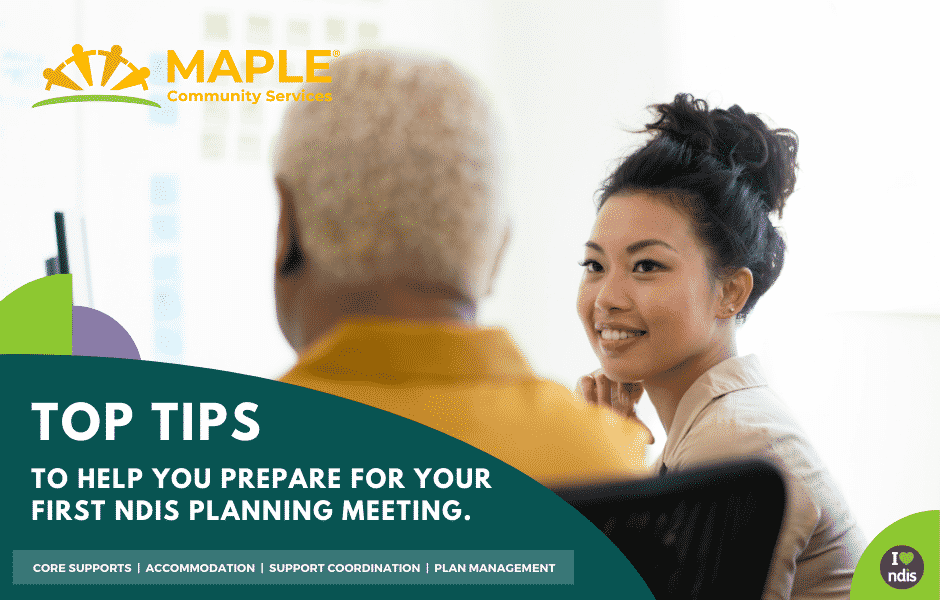Tips to help you prepare for your first NDIS Planning Meeting
The NDIS can be quite difficult and confusing to navigate, especially when it’s your first time. One way you can ensure that you are getting the most out of your NDIS plan is through being prepared and knowing what is around the corner. One of the most daunting aspects of NDIS Plans, is the NDIS Planning Meeting, so we are here to help break it down for you.
Pre-Planning for your NDIS Planning Meeting ensures that you know exactly what to expect when you first go in, and enables you to communicate the goals and dreams you want to achieve over the next year with the help of the NDIS.
So, here are some helpful tips to ensure you get the most out of your Planning Meeting, as well as useful resources to solidify that!
1. Complete an NDIS Planning Booklet
When preparing for your planning meeting, filling out the NDIS Planning Booklet is a great place to start. The Booklet is the perfect NDIS pre-planning tool as it not only asks you to think about your needs and goals for the future, but also provides space for you to reflect on your current situation. This can help to ensure that the supports you eventually choose will suit your current lifestyle and will also draw upon and enhance your current relationships and supports.
You can download a copy of the Planning Booklet via the NDIS website or by clicking on your preferred version below.
Downloads:
Booklet 2 – Planning (PDF 680KB)
Booklet 2 – Planning (DOCX 46KB)
Booklet 2 – Planning Easy Read (DOCX 62KB)
Booklet 2 – Planning Easy Read (PDF 7MB)
Having this Planning Booklet with you at your first planning meeting will also help you to ensure you don’t forget anything you want to mention, talk, or ask questions about.
2. Know what assistance you are looking for and the goals you want to achieve
Setting clear goals and addressing your needs is one of the most effective ways you can get the most out of your NDIS Plan. Think about all parts of your life and what goals you would like to achieve, both short-term and long-term. This goal setting will make apparent the kinds of supports that would be beneficial to you. In particular, you should take into consideration the areas of:
- Employment
- Education
- Social Participation
- Independence
- Living Arrangements
- Health and Wellbeing
3. Have your Reports and Evidence ready to go!
The Meeting Planner will ask for evidence to support any requests you make for supports to achieve your goals.
Hence, organise reports from therapists (such as Occupational Therapists, Speech Pathologists, Psychologists, Physiotherapists) that outline the functional impact of the disability and what specific activities or tasks will be tackled to help you achieve your goals.
If you think you need changes to your home or your vehicle or for specific aids and equipment, then try and make sure your allied health specialist includes these and demonstrates how they would help you achieve your goals.
The more information ‘at hand and ready to go’ the better!
4. Understand how you want your plan to be managed, and by who!
This may seem like a small decision, but deciding how your plan will be managed, and by who, is a major factor in the decision-making process, and enabling your independence.
You can elect to be Self-Managed, Agency Managed or Plan Managed and each option has impacts on what supports you can get and what you need to do to manage the paperwork and finances.
You need to indicate which option you prefer at your planning meeting. To help you understand the benefits and components of each option, we have provided a brief description of each below.
Self-Managed
For each service you receive, you pay for services directly and then apply to the NDIS to be reimbursed. Or you can apply to the NDIS for the amount you need, wait for the funding and then pay for your service or support. The NDIA recommends you set up a separate bank account. You need to keep records of your services and payments. Under Self-Management, you can negotiate your own price directly with the provider. Plus, you can use both unregistered and registered NDIS providers.
In short, you have more flexibility and choice, but you do need to be organised and able to handle the paperwork.
NDIA or Agency Managed
Service providers will need to send their invoices directly to the NDIA and the NDIA pays them. However, under this option, you can only use providers that are registered with the NDIA. And they must be paid the NDIA rates.
There is a lot less flexibility with the NDIA managed option.
Plan Managed
Under this option, an independent organisation such as Maple Community Services does the paperwork and organises payments from your NDIS plan for the services you receive. The Plan Manager sends you monthly statements so you can see how you’re going with your NDIS budget.
You don’t pay for the Plan Management service and it does not impact the funding for any other supports in your NDIS plan.
With Plan Management, you can use both registered and unregistered providers, so you have the same flexibility as Self-Management but without the hassle of the paperwork and having to log into the portal.
Lastly, you can have a mixture of these 3 management options if there are some parts of your plan you want more control over than others.
Maple Community Services NDIS Plan Assistance
If you have any questions around what is an NDIS Plan, or would purely like to chat to a Maple Community Services representative around the role we play in assisting you with your Plan Management needs, please get in touch with us today.
Phone: 1800 780 964
Email: [email protected]



